Deformation-Related Data Mining and Movement Patterns of the Huangtupo Landslide in the Three Gorges Reservoir Area of China
Abstract
1. Introduction
2. Background
2.1. Geological Setting
2.2. Deformation Characteristic of the Landslide
3. Method
3.1. K-Means Clustering Method
- (1)
- The number of clusters (K) is determined using methods such as the Elbow method and Silhouette analysis. K initial cluster centers (C1, C2, …, CK) are randomly selected from the N sample datasets.
- (2)
- The Euclidean distance (as defined in Equation (1)) between each cluster center Ci and the remaining data objects X is calculated to identify the target objects closest to the cluster center Ci, which are classified as the cluster members of cluster i, where m is the dimension of the data objects, Cij is the value of the jth dimension of the cluster center Ci, and Xj is the value of the jth dimension of the data object X.
- (3)
- For each cluster, i obtains ni samples, ∑ni = N, where i = 1, 2, …, K. The mean vector Mi (Equation (2)) of cluster i is defined as the centroid of the cluster. This is updated to the new cluster center Ci, where Xji is the jth sample belonging to cluster i:
- (4)
- The sum of squared errors (SSE, as defined in Equation (3)) for all data objects is an important indicator for measuring clustering performance when aiming to improve the tightness of the cluster by minimizing SSE. SSE is calculated as follows:
- (5)
- It is necessary to repeat steps (2)–(4). The calculations are updated iteratively, depending on the Euclidean distances between cluster members and centers, until a stable position is reached where the cluster centers no longer change. Alternatively, the maximum number of iterations is reached, or the SSE is locally minimized.
3.2. FP-Growth Algorithm
3.2.1. Basic Concept
- (1)
- Itemset Q is a collection of items Qi, which is defined aswhere QF is the front itemset and QR is the rear itemset, with and . There is no intersection between QF and QR, namely, . For the landslide deformation response analysis, QF and QR represent the triggering factors and the deformation events, respectively.
- (2)
- Transaction database P consists of task-related transaction items, with P = {P1, P2, …, Pn}, . Each transaction Pk is a nonempty itemset, containing at least one front item and one rear item.
- (3)
- The antecedent item X is the nonempty proper subsets of QF, and the consequent item Y is the nonempty proper subsets of QR. The association rule (AR) represents a correlation between items, like AR X ⇒ Y. X is regarded as the condition of AR, while Y is regarded as the conclusion of AR. It means that if item X occurs, item Y will also occur with a certain probability.
- (4)
- Support refers to the probability of items X and Y appearing simultaneously in the collection of transaction database P, namely, the proportion of transactions containing both X and Y to the total transactions in the database, which is defined as follows:
- (5)
- Confidence indicates the occurrence probability of Y, assuming that X has already occurred, which is defined as follows:
- (6)
- Lift denotes the degree to which the Y is affected by the appearance of X in the collection of transaction database P. The appearance of X promotes the Y when the value of lift is greater than one. The expression is as follows:
3.2.2. Computation Process
- (1)
- First, the transaction database is scanned overall, calculating the support for each item separately. The minimum support is set to filter the frequent itemset, which will be sorted in the frequent-item header table L in descending order of support count (Figure 7a).
- (2)
- Second, scan the transaction database, and construct the FP-Tree based on all frequent itemset. The root labeled as “null” will be built first, and then the frequent itemset is inserted into the children of the root by following the order of the frequent-item header table L.
- (3)
- The head of the node-link is created to facilitate searching FP-Tree (Figure 7b) by connecting each frequent itemset to the tree node of the FP-Tree.
- (4)
- Based on the links between the frequent-item header table L and the tree nodes, a bottom-up approach is adopted to mine the strong association rules for the priority tree.
4. Results
4.1. Deformation Correlation Factors
- (1)
- Reservoir Water Level
- (2)
- Rainfall
- (3)
- Surface Deformation
4.2. Clustering Results
4.3. Association Rules Mining
5. Discussion
- The influence of reservoir water levels is characterized by the following features: (i) a decline in the reservoir water level reduces the hydrostatic pressure on the landslide, decreasing the normal pressure σ on the sliding surface, thereby reducing the resistance force τf. This increases the tendency for the sliding mass to slide downward along the sliding surface. (ii) The decline in the groundwater table within the slope lags behind that in the reservoir water level, generating a downslope-directed seepage pressure Pw (Figure 12b), which increases the sliding force of the shallow sliding mass; (iii) when the reservoir water level is rising, the aforementioned influences exert the opposite effects, effectively reducing the deformation velocity (Figure 12c).
- The influence of rainfall is characterized by the following: (i) rainfall infiltration generates a downslope-directed seepage pressure Pr, which increases the sliding force of the landslide; (ii) rainfall infiltration raises the groundwater table, increasing the saturated zone within the slope. This induces an increase in pore water pressure, dissipating the suction stress [43], thereby lowering the resistance force τf and accelerating landslide deformation (Figure 12d).
6. Conclusions
- (1)
- The clustering analysis and data mining algorithms utilized in this study effectively extracted association rules from a substantial volume of monitoring data, thereby revealing potential relationships among reservoir water levels, rainfall, and landslide deformation. The reliability of these findings has been thoroughly validated, and the methodologies can be applied to analyze the deformation characteristics and triggering factors of reservoir-induced landslides based on monitoring data. By identifying key correlations between triggering factors and landslide deformation, this approach is expected to support real-time monitoring systems, enabling the timely detection of risk factors for potential landslides.
- (2)
- The results of the association rule analysis indicate that reservoir water levels exert a relatively uniform influence on overall landslide behavior. Specifically, declines in reservoir water levels (−18.70 to −2.16 m/month) under medium-to-low levels (146.43 to 163.23 m) can significantly accelerate landslide deformation, whereas high reservoir water levels (165.37 to 175.10 m) and rising water levels (4.45 to 17.33 m/month) tend to suppress it. Rainfall appears to have a negligible effect on the front of the landslide but positively influences deformation in the middle and rear sections. Additionally, the high-level deformation phase at the rear section (3.5 to 6.3 m) is strongly consistent with that at the middle (5.0 to 7.9 m), but it differs from the trend at the front (6.0 to 21.0 m), highlighting the spatial variability in the deformation mechanisms.
- (3)
- The deformation velocity trends at monitoring points P5 and P7 are generally consistent, while P2 exhibits less consistency with these points. We hypothesize that this discrepancy is attributable to the proximity of the groundwater table to the front monitoring point and its greater distance from the middle and rear sections. The downslope-directed seepage pressure Pw significantly affects the front, resulting in an additional peak in velocity at low reservoir water levels following a decline.
- (4)
- Landslide deformation demonstrates a gradual increase from the rear to the front and from west to east, indicating that the reservoir water level near the front of the landslide plays a crucial role in accelerating landslide deformation. The movement pattern is in accordance with the behavior of a retrogressive landslide, supporting the classification of the No. 1 riverside sliding mass as a retrogressive type. This characteristic provides valuable insights for managing similar landslides that exhibit comparable geological and hydrological conditions, suggesting that priority should be given to drainage systems, such as drainage ditches and geo-drains, and support structures, like retaining walls and soil nails, at the landslide front to mitigate retrogressive-type deformation. In addition, these findings are expected to advance research on landslide deformation forecasting and the development of early warning systems.
Author Contributions
Funding
Data Availability Statement
Acknowledgments
Conflicts of Interest
References
- Li, K.; Zhu, C.; Wu, L.; Huang, L. Problems caused by the Three Gorges Dam construction in the Yangtze River basin: A review. Environ. Rev. 2013, 21, 127–135. [Google Scholar] [CrossRef]
- Ma, J.; Wang, Y.; Niu, X.; Jiang, S.; Liu, Z. A comparative study of mutual information-based input variable selection strategies for the displacement prediction of seepage-driven landslides using optimized support vector regression. Stoch. Environ. Res. Risk Assess. 2022, 36, 3109–3129. [Google Scholar] [CrossRef]
- Tang, H.; Wasowski, J.; Juang, C.H. Geohazards in the Three Gorges Reservoir Area, China-Lessons learned from decades of research. Eng. Geol. 2019, 261, 105267. [Google Scholar] [CrossRef]
- Huang, B.; Yin, Y.; Liu, G.; Wang, S.; Chen, X.; Huo, Z. Analysis of waves generated by Gongjiafang landslide in Wu Gorge, three Gorges reservoir, on 23 November 2008. Landslides 2012, 9, 395–405. [Google Scholar] [CrossRef]
- Luo, S.; Huang, D. Deformation characteristics and reactivation mechanisms of the Outang ancient landslide in the Three Gorges Reservoir, China. Bull. Eng. Geol. Environ. 2020, 79, 3943–3958. [Google Scholar] [CrossRef]
- Wang, F.; Zhang, Y.; Huo, Z.; Peng, X.; Wang, S.; Yamasaki, S. Mechanism for the rapid motion of the Qianjiangping landslide during reactivation by the first impoundment of the Three Gorges Dam reservoir, China. Landslides 2008, 5, 379–386. [Google Scholar] [CrossRef]
- Tang, H.; Li, C.; Hu, X.; Su, A.; Wang, L.; Wu, Y.; Criss, R.; Xiong, C.; Li, Y. Evolution characteristics of the Huangtupo landslide based on in situ tunneling and monitoring. Landslides 2015, 12, 511–521. [Google Scholar] [CrossRef]
- Deng, Q.; Fu, M.; Ren, X.; Liu, F.; Tang, H. Precedent long-term gravitational deformation of large scale landslides in the Three Gorges reservoir area, China. Eng. Geol. 2017, 221, 170–183. [Google Scholar] [CrossRef]
- Luo, S.; Jin, X.; Huang, D.; Kuang, X.; Song, Y.; Gu, D. Reactivation of a huge, deep-seated, ancient landslide: Formation mechanism, deformation characteristics, and stability. Water 2020, 12, 1960. [Google Scholar] [CrossRef]
- Zheng, W.; Sun, Q.; Hu, J.; Lu, Z.; Zhu, K.; Ye, X.; Huang, G.; Hu, M.; Zhu, J.; Li, Z. Investigating kinematics and triggers of slow-moving reservoir landslide using an improved MT-InSAR method. Geomat. Nat. Hazards Risk 2023, 14, 2289835. [Google Scholar] [CrossRef]
- Xu, Q.; Liu, H.; Ran, J.; Li, W.; Sun, X. Field monitoring of groundwater responses to heavy rainfalls and the early warning of the Kualiangzi landslide in Sichuan Basin, southwestern China. Landslides 2016, 13, 1555–1570. [Google Scholar] [CrossRef]
- Crosta, G.B.; Agliardi, F. Failure forecast for large rock slides by surface displacement measurements. Can. Geotech. J. 2003, 40, 176–191. [Google Scholar] [CrossRef]
- Uhlemann, S.; Smith, A.; Chambers, J.; Dixon, N.; Dijkstra, T.; Haslam, E.; Meldrum, P.; Merritt, A.; Gunn, D.; Mackay, J. Assessment of ground-based monitoring techniques applied to landslide investigations. Geomorphology 2016, 253, 438–451. [Google Scholar] [CrossRef]
- Xu, Q.; Peng, D.; Zhang, S.; Zhu, X.; He, C.; Qi, X.; Zhao, K.; Xiu, D.; Ju, N. Successful implementations of a real-time and intelligent early warning system for loess landslides on the Heifangtai terrace, China. Eng. Geol. 2020, 278, 105817. [Google Scholar] [CrossRef]
- Franceschini, R.; Rosi, A.; Catani, F.; Casagli, N. Exploring a landslide inventory created by automated web data mining: The case of Italy. Landslides 2022, 19, 841–853. [Google Scholar] [CrossRef]
- Ma, J.; Tang, H.; Liu, X.; Hu, X.; Sun, M.; Song, Y. Establishment of a deformation forecasting model for a step-like landslide based on decision tree C5.0 and two-step cluster algorithms: A case study in the Three Gorges Reservoir area, China. Landslides 2017, 14, 1275–1281. [Google Scholar] [CrossRef]
- Zhang, Y.; Tang, J.; He, Z.; Tan, J.; Li, C. A novel displacement prediction method using gated recurrent unit model with time series analysis in the Erdaohe landslide. Nat. Hazards 2020, 105, 783–813. [Google Scholar] [CrossRef]
- Lee, S.; Lee, M.J.; Jung, H.S. Data mining approaches for landslide susceptibility mapping in Umyeonsan, Seoul, South Korea. Appl. Sci. 2017, 7, 683. [Google Scholar] [CrossRef]
- Zhao, X.; Chen, W. GIS-based evaluation of landslide susceptibility models using certainty factors and functional trees-based ensemble techniques. Appl. Sci. 2019, 10, 16. [Google Scholar] [CrossRef]
- GB T 32864–2006; People’s Republic of China National Standard. Code for Geological Investigation of Landslide Prevention. China Standardization Press: Beijing, China, 2016.
- Petley, D.; Hearn, G.; Hart, A.; Rosser, N.; Dunning, S.; Mitchell, W. Trends in landslide occurrence in Nepal. Nat. Hazards 2007, 42, 44. [Google Scholar] [CrossRef]
- Yin, Y.; Wang, H.; Gao, Y.; Li, X. Real-time monitoring and early warning of landslides at relocated Wushan Town, the Three Gorges Reservoir, China. Landslides 2010, 7, 339–349. [Google Scholar] [CrossRef]
- Du, J.; Yin, K.; Lacasse, S. Displacement prediction in colluvial landslides, Three Gorges Reservoir, China. Landslides 2013, 10, 203–218. [Google Scholar] [CrossRef]
- Huang, D.; Gu, D.; Song, Y.; Cen, D.; Zeng, B. Towards a complete understanding of the triggering mechanism of a large reactivated landslide in the Three Gorges Reservoir. Eng. Geol. 2018, 238, 36–51. [Google Scholar] [CrossRef]
- Huang, H.; Yi, W.; Lu, S.; Yi, Q.; Zhang, G. Use of monitoring data to interpret active landslide movements and hydrological triggers in three gorges reservoir. J. Perform. Constr. Fac. 2016, 30, C4014005. [Google Scholar] [CrossRef]
- Tan, F.; Hu, X.; He, C.; Zhang, Y.; Zhang, H.; Zhou, C.; Wang, Q. Identifying the main control factors for different deformation stages of landslide. Geotech. Geol. Eng. 2018, 36, 469–482. [Google Scholar] [CrossRef]
- Miao, F.; Wu, Y.; Li, L.; Liao, K.; Xue, Y. Triggering factors and threshold analysis of baishuihe landslide based on the data mining methods. Nat. Hazards 2021, 105, 2677–2696. [Google Scholar] [CrossRef]
- Guo, L.; Miao, F.; Zhao, F.; Wu, Y. Data mining technology for the identification and threshold of governing factors of landslide in the Three Gorges Reservoir area. Stoch. Environ. Res. Risk Assess. 2022, 36, 3997–4012. [Google Scholar] [CrossRef]
- Li, L.; Wu, Y.; Huang, Y.; Li, B.; Miao, F.; Deng, Z. Optimized Apriori algorithm for deformation response analysis of landslide hazards. Comput. Geosci. 2023, 170, 105261. [Google Scholar] [CrossRef]
- Wang, J.; Su, A.; Liu, Q.; Xiang, W.; Yeh, H.-F.; Xiong, C.; Zou, Z.; Zhong, C.; Liu, J.; Cao, S. Three-dimensional analyses of the sliding surface distribution in the Huangtupo No. 1 riverside sliding mass in the Three Gorges Reservoir area of China. Landslides 2018, 15, 1425–1435. [Google Scholar] [CrossRef]
- Wang, S.; Wang, J.; Wu, W.; Cui, D.; Su, A.; Xiang, W. Creep properties of clastic soil in a reactivated slow-moving landslide in the Three Gorges Reservoir Region, China. Eng. Geol. 2020, 267, 105493. [Google Scholar] [CrossRef]
- Deng, Q.; Zhu, Z.; Cui, Z.; Wang, X. Mass rock creep and landsliding on the Huangtupo slope in the reservoir area of the Three Gorges Project, Yangtze River. Eng. Geol. 2000, 58, 67–83. [Google Scholar] [CrossRef]
- Li, C.; Tang, H.; Han, D.; Zou, Z. Exploration of the creep properties of undisturbed shear zone soil of the Huangtupo landslide. Bull. Eng. Geol. Environ. 2019, 78, 1237–1248. [Google Scholar] [CrossRef]
- Tang, H.; Li, C.; Hu, X.; Wang, L.; Criss, R.; Su, A.; Wu, Y.; Xiong, C. Deformation response of the Huangtupo landslide to rainfall and the changing levels of the Three Gorges Reservoir. Bull. Eng. Geol. Environ. 2014, 74, 933–942. [Google Scholar] [CrossRef]
- Toma’s, R.; Li, Z.; Liu, P.; Singleton, A.; Hoey, T.; Cheng, X. Spatiotemporal characteristics of the Huangtupo landslide in the Three Gorges region (China) constrained by radar interferometry. Geophys. J. Int. 2014, 197, 213–232. [Google Scholar] [CrossRef]
- MacQueen, J.B. On the Asymptotic Behavior of k-Means; Defense Technical Information Center: Fort Belvoir, VA, USA, 1965. [Google Scholar]
- Han, J.; Kamber, M. Data Mining: Concepts and Techniques//Data Mining Concepts Models Methods & Algorithms, 2nd ed.; Morgan Kaufmann Publishers Inc.: San Francisco, CA, USA, 2005. [Google Scholar]
- Sun, G.; Zheng, H.; Tang, H.; Dai, F. Huangtupo landslide stability under water level Fluctuations of the Three Gorges reservoir. Landslides 2016, 13, 1167–1179. [Google Scholar] [CrossRef]
- Zhang, L.; Shi, B.; Zhu, H.; Yu, X.; Han, H.; Fan, X. PSO-SVM-based deep displacement prediction of Majiagou landslide considering the deformation hysteresis effect. Landslides 2021, 18, 179–193. [Google Scholar] [CrossRef]
- Tsironi, V.; Ganas, A.; Karamitros, I.; Efstathiou, E.; Koukouvelas, I.; Sokos, E. Kinematics of active landslides in Achaia (Peloponnese, Greece) through InSAR time series analysis and relation to rainfall patterns. Remote Sens. 2022, 14, 844. [Google Scholar] [CrossRef]
- Hungr, O.; Leroueil, S.; Picarelli, L. The Varnes classification of landslide types, an update. Landslides 2014, 11, 167–194. [Google Scholar] [CrossRef]
- Luo, S.L.; Jin, X.G.; Huang, D. Long-term coupled effects of hydrological factors on kinematic responses of a reactivated landslide in the Three Gorges Reservoir. Eng. Geol. 2019, 261, 105271. [Google Scholar] [CrossRef]
- Lu, N.; Likos, W.J. Suction stress characteristic curve for unsaturated soil. J. Geotech. Geoenviron. 2006, 132, 131–142. [Google Scholar] [CrossRef]
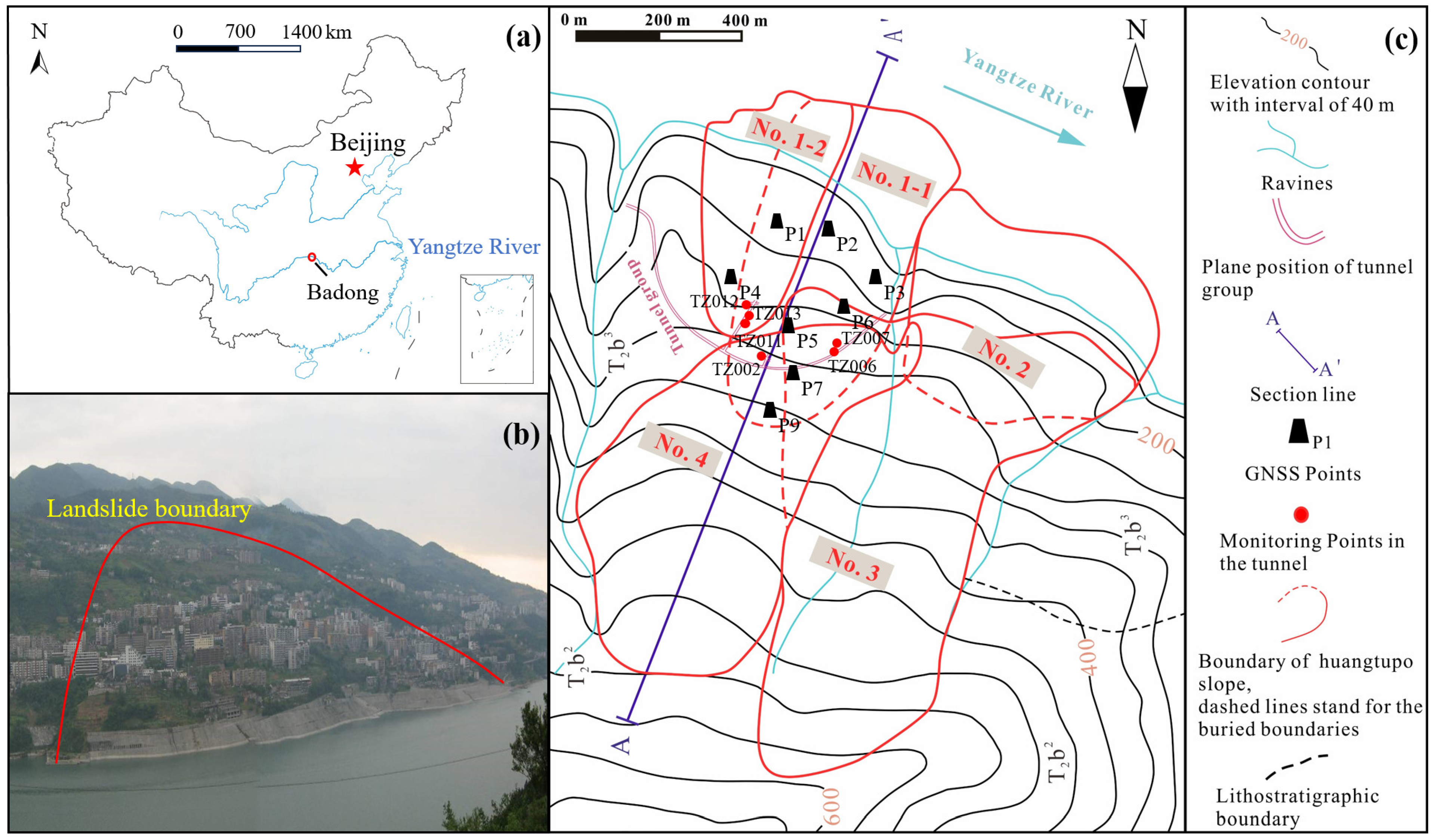
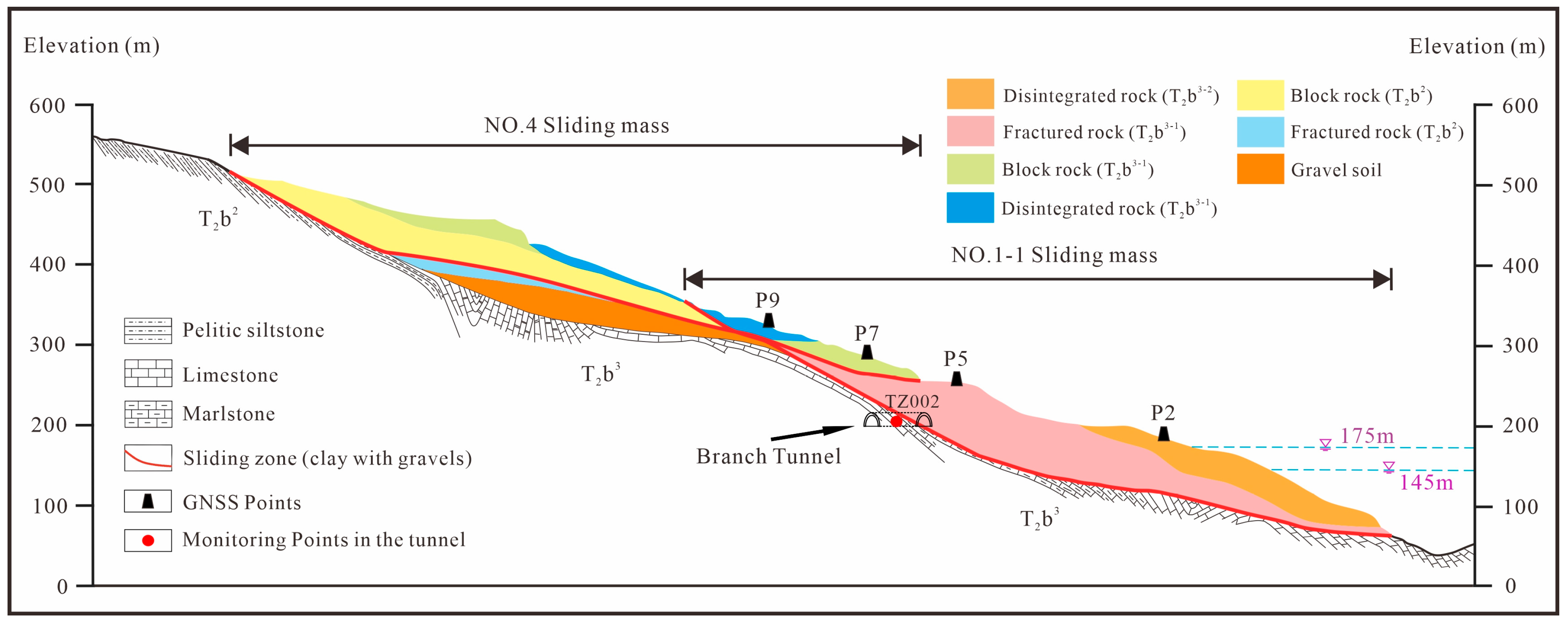
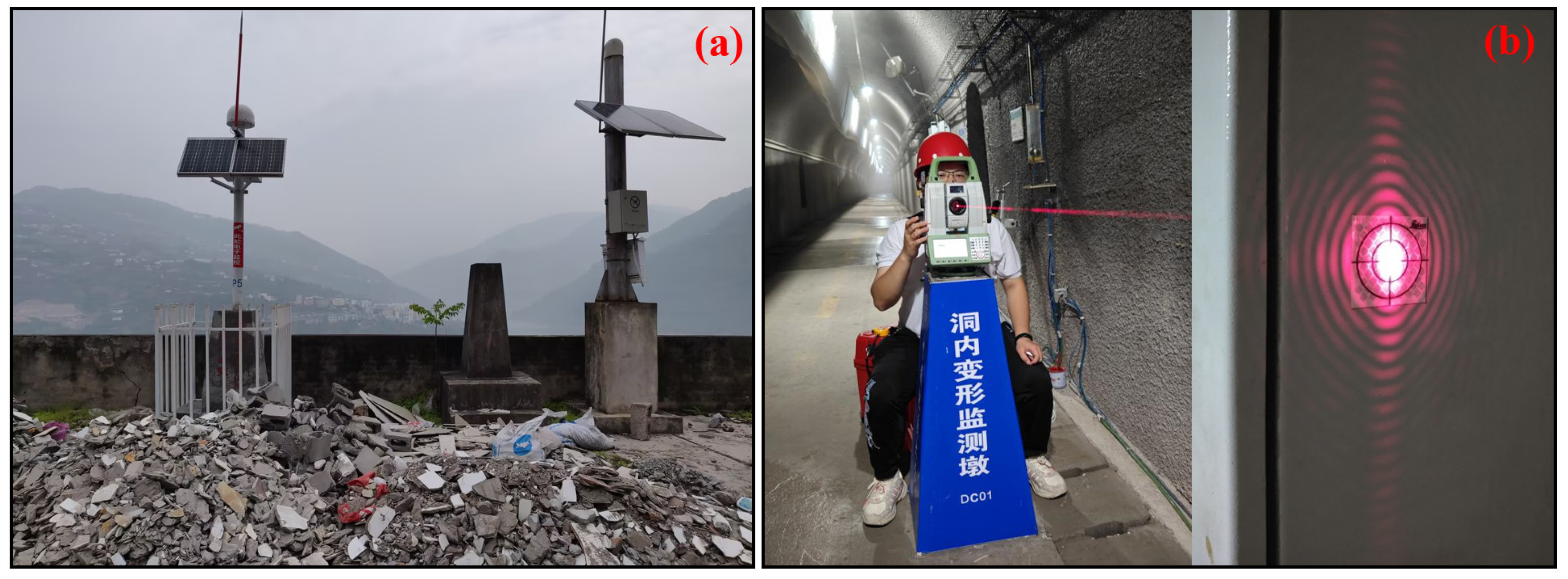
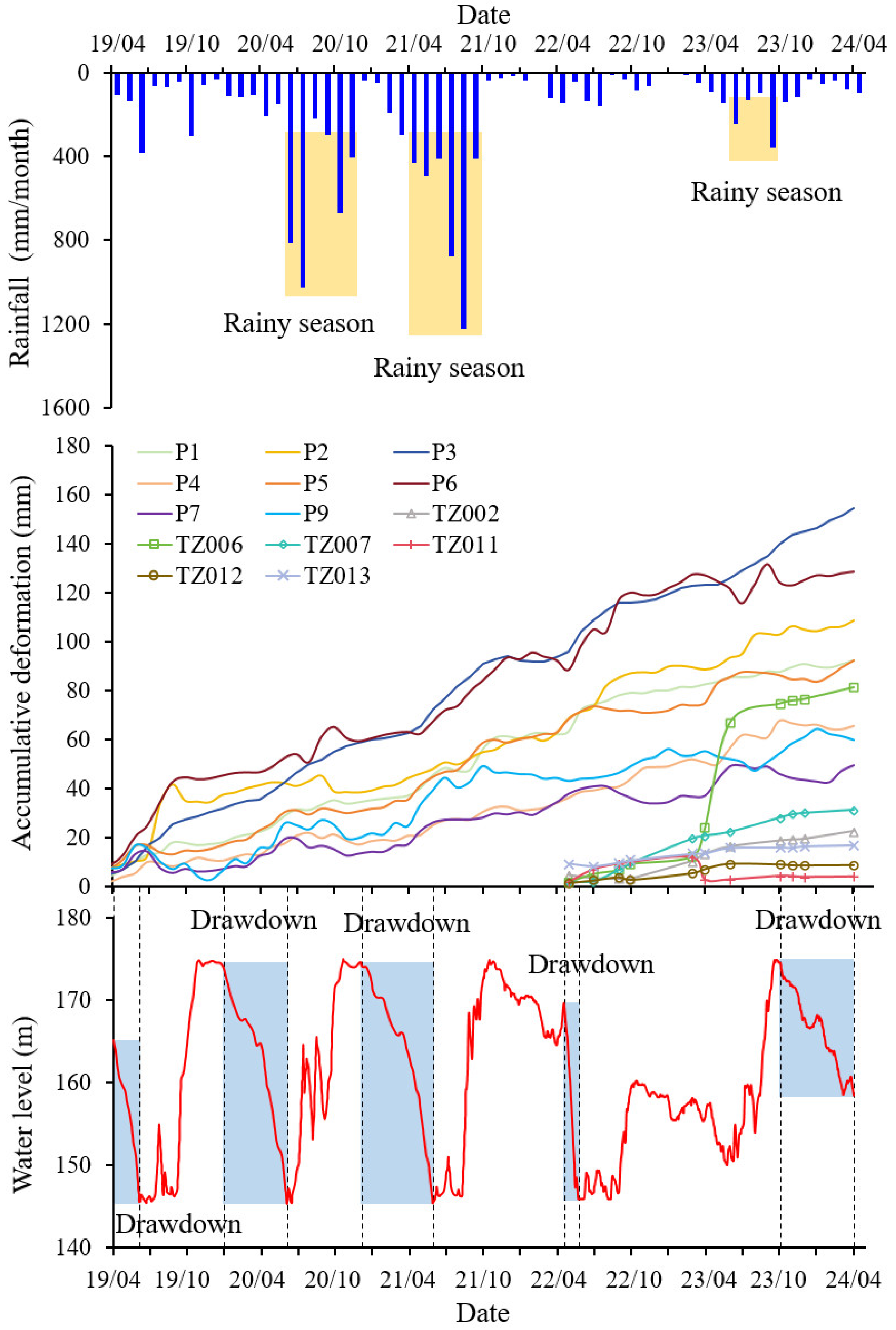
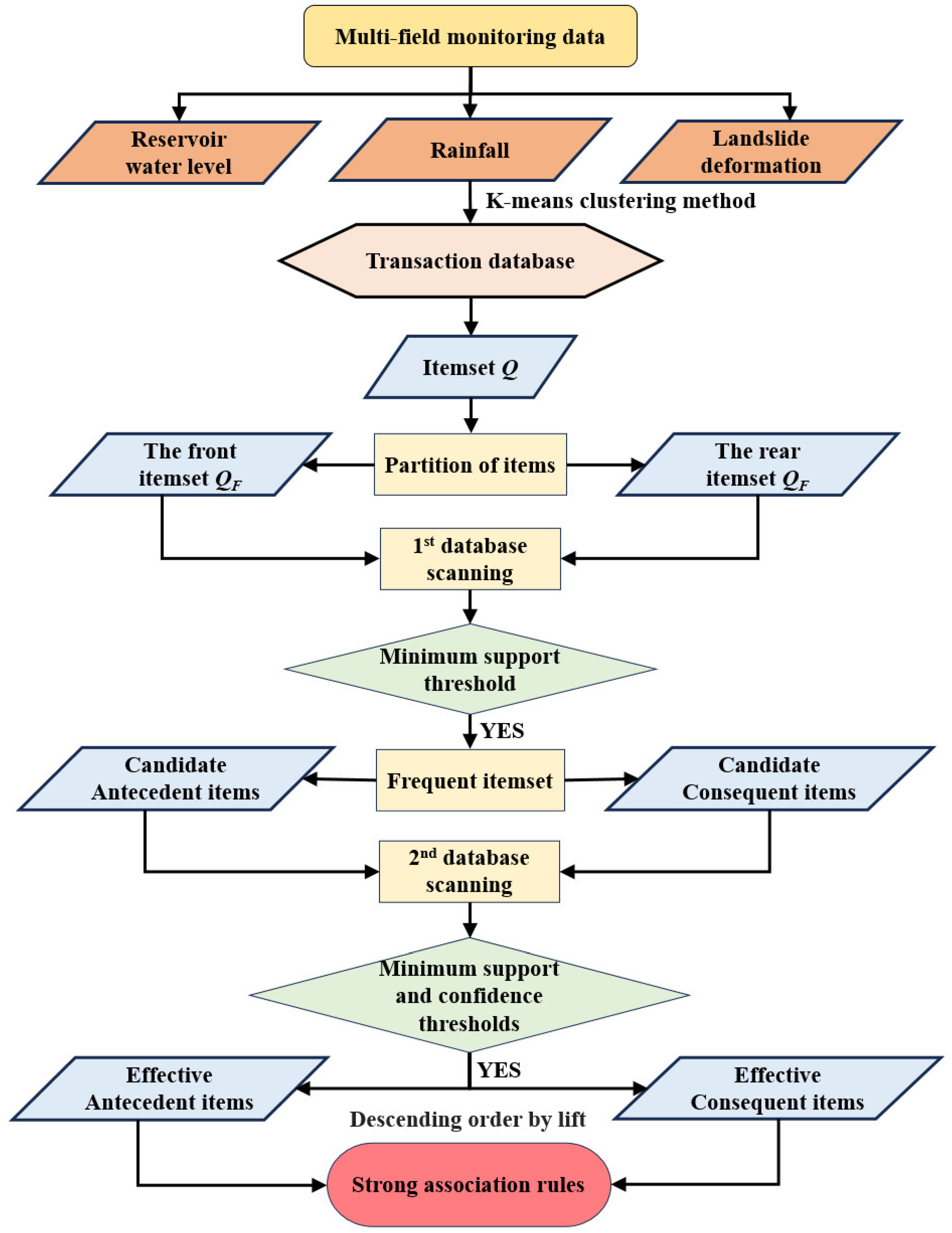
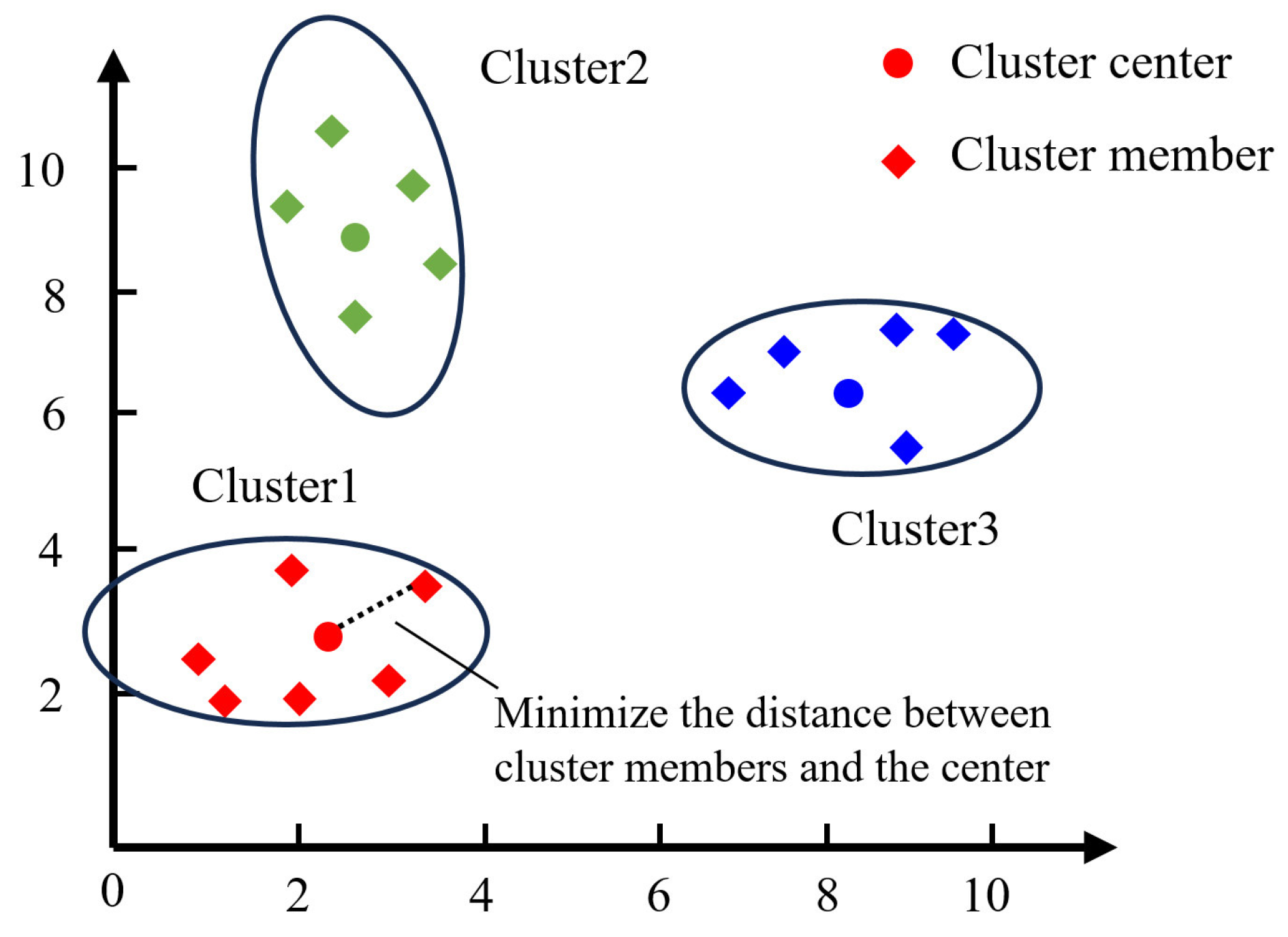
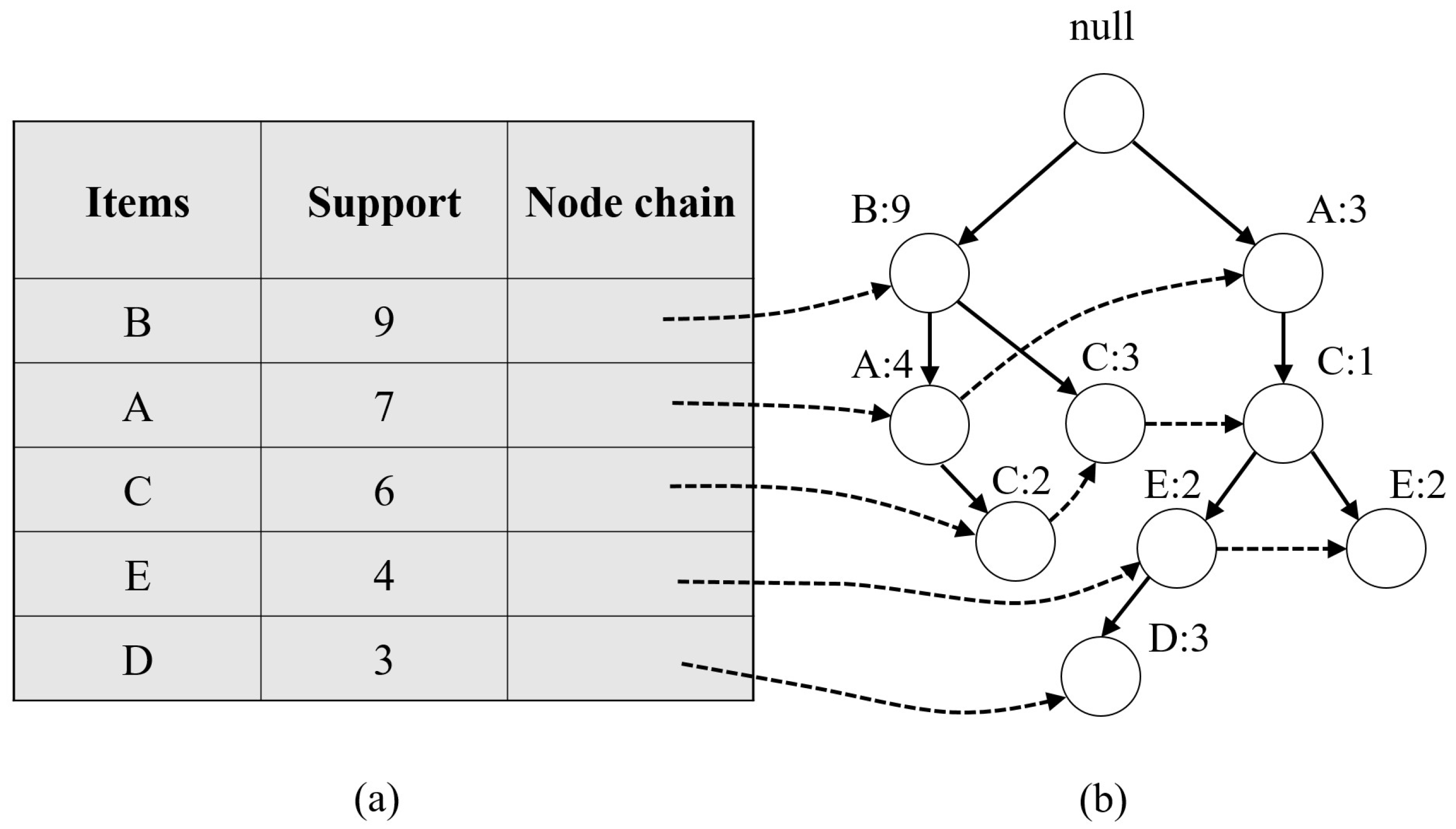


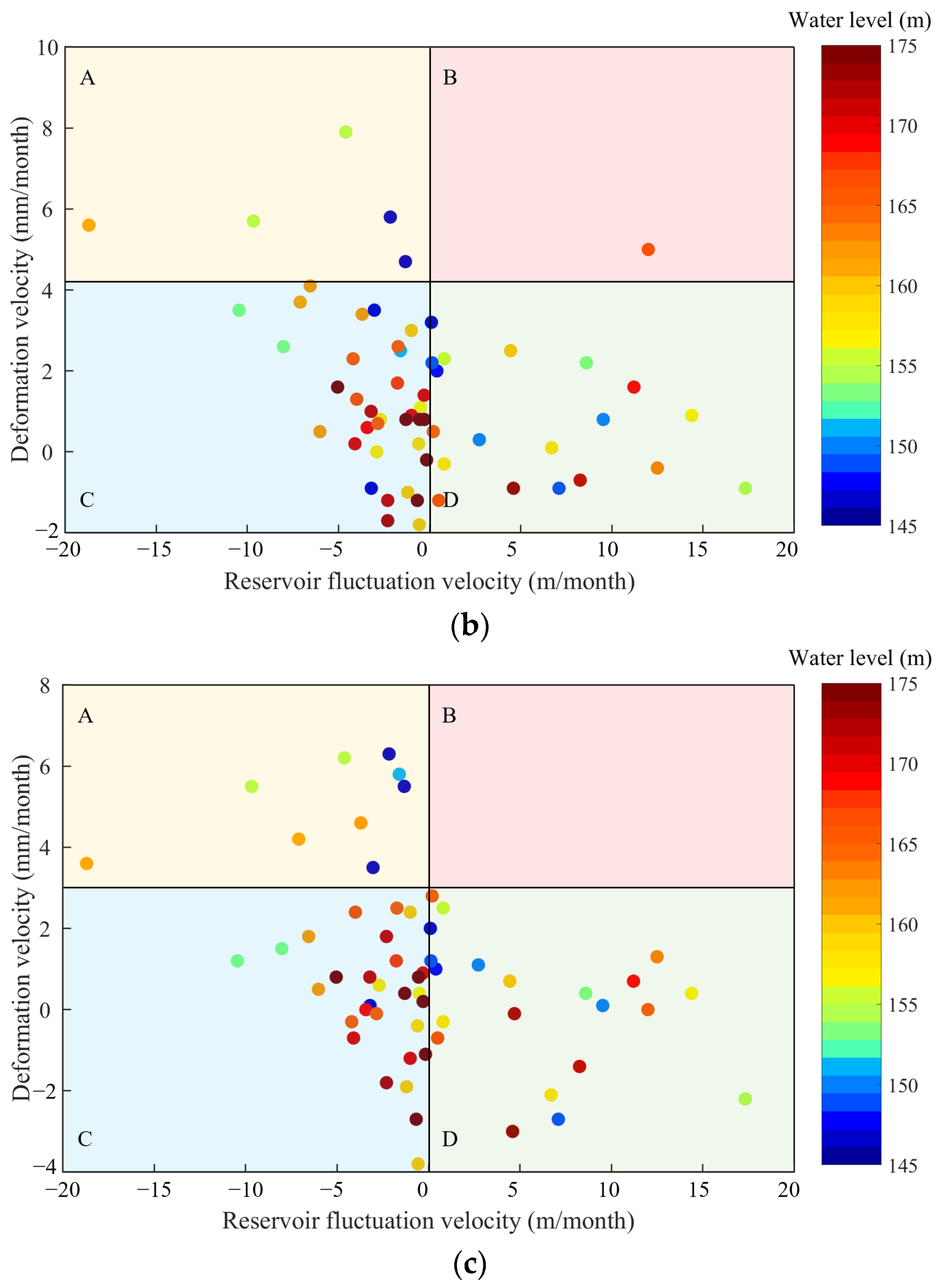
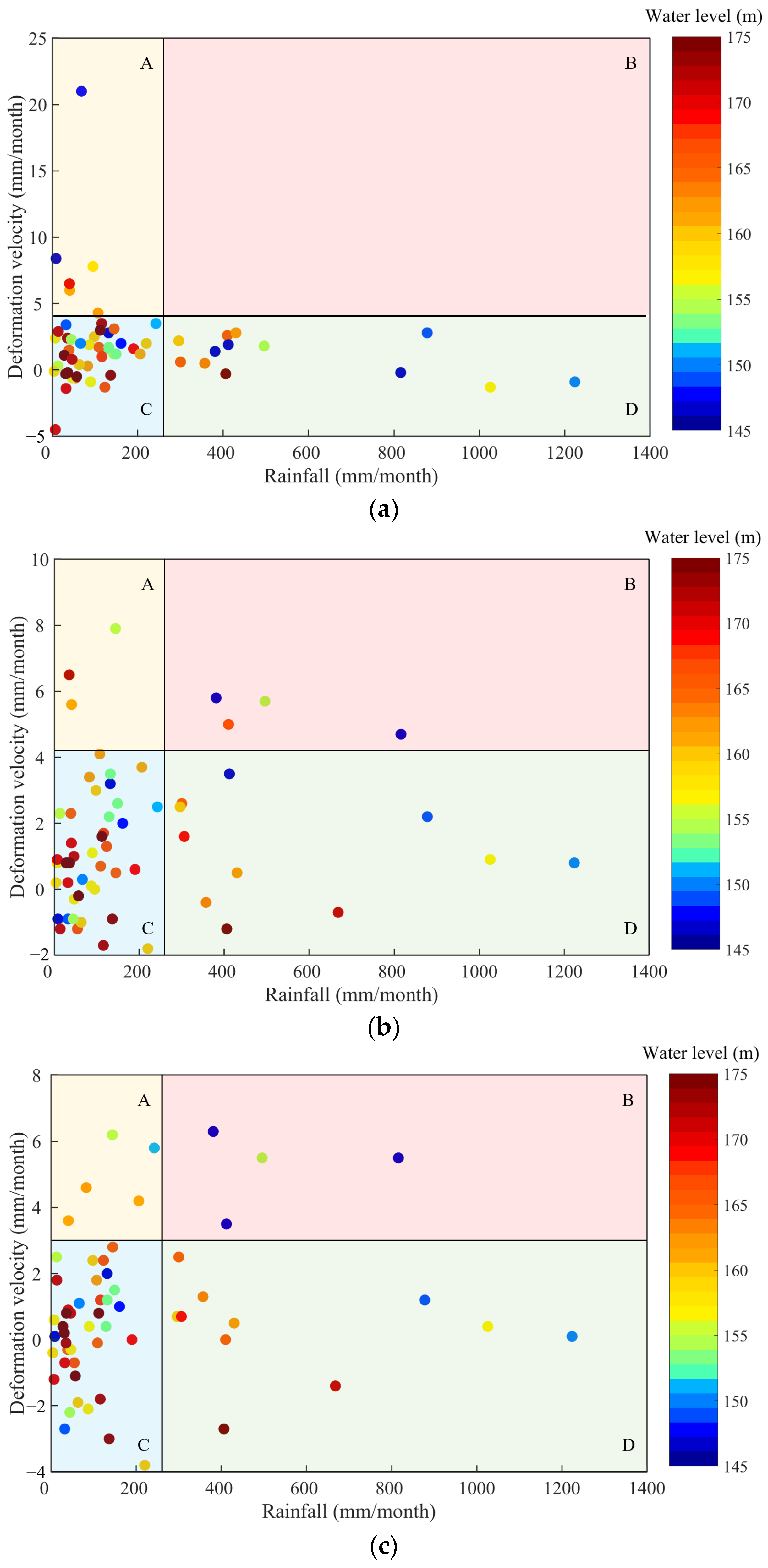


| Category | Factors | Clustering Results | Count | |
|---|---|---|---|---|
| Water level | /month | (146.32, 154.95) | Low-Water-Level | 18 |
| (155.87, 163.23) | Medium-Water-Level | 17 | ||
| (165.37, 175.10) | High-Water-Level | 26 | ||
| ΔR/month | (−18.70, −8.02) | Sharply Drop | 4 | |
| (−7.10, −2.16) | Slowly Drop | 21 | ||
| (−1.76, 2.73) | Stable-Fluctuation | 23 | ||
| (4.45, 9.53) | Slowly Rise | 8 | ||
| (11.21, 17.33) | Sharply Rise | 5 | ||
| Rainfall | ∑qmonth/mm | (0, 220) | Light-Rainfall | 45 |
| (242, 496) | Moderate-Rainfall | 11 | ||
| (668, 1224) | Heavy-Rainfall | 5 | ||
| /mm | (2.7, 68.2) | Light Daily Rainfall | 43 | |
| (76, 172) | Moderate Daily Rainfall | 12 | ||
| (200, 296) | Heavy Daily Rainfall | 6 |
| Rule ID | Antecedent Items | Consequent Items | Support /% | Confidence/% | Lift |
|---|---|---|---|---|---|
| 1 | = Medium-Water-Level, ΔR = Slowly Rise, ∑qmonth = Heavy Daily Rainfall, D (P5)= Low, D (P7)= Low | D = Low | 6.6 | 100 | 2.65 |
| 2 | = Light Daily Rainfall, D (P5) = Low | 8.2 | 83.3 | 2.21 | |
| 3 | = High-Water-Level, ΔR = Stable-Fluctuation, ∑qmonth = Light-Rainfall, D (P5) = Low | 6.6 | 66.7 | 1.77 | |
| 4 | = High-Water-Level, ΔR = Slowly Rise, ∑qmonth = Moderate Daily Rainfall | 6.6 | 66.7 | 1.77 | |
| 5 | = Medium-Water-Level, ΔR = Sharply Drop, ∑qmonth = Moderate Daily Rainfall, D (P7) = Medium | D = Medium | 6.6 | 100 | 1.91 |
| 6 | = Light Daily Rainfall, D (P5) = Medium, D (P7) = Medium | 6.6 | 80 | 1.53 | |
| 7 | = Low-Water-Level, ΔR = Slowly Drop | 6.6 | 80 | 1.53 | |
| 8 | = Low-Water-Level, ΔR = Light Daily Rainfall, D (P7) = Low | D = High | 6.6 | 82.5 | 6.78 |
| 9 | = Low-Water-Level, ∑qmonth = Light-Rainfall, D (P5) = Low, D (P7) = Low | 6.6 | 66.7 | 6.78 | |
| 10 | = Low-Water-Level, ΔR = Stable-Fluctuation, ∑qmonth = Light Daily Rainfall, D (P7) = Low | 6.6 | 66.7 | 6.78 |
| Rule ID | Antecedent Items | Consequent Items | Support /% | Confidence/% | Lift |
|---|---|---|---|---|---|
| 1 | = Medium-Water-Level, Δ = Light Daily Rainfall, D (P7) = Low | D = Low | 6.6 | 100 | 1.85 |
| 2 | = High-Water-Level, Δ = Heavy Daily Rainfall, D (P2) = Low, D (P7) = Low | 6.6 | 100 | 1.85 | |
| 3 | = High-Water-Level, ΔR = Stable-Fluctuation, ∑qmonth = Light-Rainfall, D (P2) = Low | 6.6 | 80 | 1.48 | |
| 4 | = Medium-Water-Level, ΔR = Slowly Drop, ∑qmonth = Light-Rainfall, D (P7) = Medium | D = Middle | 6.6 | 100 | 2.91 |
| 5 | = Medium-Water-Level, ΔR = Slowly Drop, ∑qmonth = Light Daily Rainfall | 6.6 | 100 | 2.91 | |
| 6 | ΔR = Slowly Drop, D (P2) = Medium, D (P7) = Medium | 9.8 | 75 | 2.18 | |
| 7 | = Low-Water-Level, Δ = Moderate Daily Rainfall, D (P2) = Medium, D (P7) = High | D = High | 6.6 | 87.5 | 2.18 |
| 8 | = Low-Water-Level, ΔR = Sharply Drop, ∑qmonth = Moderate Daily Rainfall, D (P2) = Low | 6.6 | 66.7 | 1.68 |
| Rule ID | Antecedent Items | Consequent Items | Support /% | Confidence/% | Lift |
|---|---|---|---|---|---|
| 1 | = Medium-Water-Level, ΔR = Stable-Fluctuation, ∑qmonth = Light Daily Rainfall, D (P5) = Low | D = Low | 6.6 | 100 | 1.91 |
| 2 | = Medium-Water-Level, ∑qmonth = Light-Rainfall, D (P5) = Low, D (P7) = Low | 8.2 | 100 | 1.91 | |
| 3 | = High-Water-Level, ΔR = Slowly Drop, ∑qmonth = Light-Rainfall, D (P5) = Low | 8.2 | 71.4 | 1.36 | |
| 4 | = Medium-Water-Level, ΔR = Slowly Drop, ∑qmonth = Light-Rainfall | D = Middle | 6.6 | 100 | 3.21 |
| 5 | = Medium-Water-Level, ΔR = Light Daily Rainfall, D (P5) = Medium | 6.6 | 100 | 3.21 | |
| 6 | ΔR = Slowly Drop, ∑qmonth = Light Daily Rainfall, D (P2) = Medium | 11.5 | 87.5 | 2.81 | |
| 7 | = Low-Water-Level, ΔR = Sharply Drop, ∑qmonth = Moderate-Rainfall, D (P5) = High | D = High | 6.6 | 80 | 4.88 |
| 8 | = Low-Water-Level, ΔR = Sharply Drop, ∑qmonth = Heavy-Rainfall, D (P2) = Low | 6.2 | 71.4 | 1.68 | |
| 9 | = Low-Water-Level, ΔR = Heavy Daily Rainfall, D (P2) = Medium | 6.2 | 71.4 | 1.51 |
Disclaimer/Publisher’s Note: The statements, opinions and data contained in all publications are solely those of the individual author(s) and contributor(s) and not of MDPI and/or the editor(s). MDPI and/or the editor(s) disclaim responsibility for any injury to people or property resulting from any ideas, methods, instructions or products referred to in the content. |
© 2025 by the authors. Licensee MDPI, Basel, Switzerland. This article is an open access article distributed under the terms and conditions of the Creative Commons Attribution (CC BY) license (https://creativecommons.org/licenses/by/4.0/).
Share and Cite
Liao, Z.; Wang, J.; Chen, G.; Li, Y. Deformation-Related Data Mining and Movement Patterns of the Huangtupo Landslide in the Three Gorges Reservoir Area of China. Appl. Sci. 2025, 15, 4018. https://doi.org/10.3390/app15074018
Liao Z, Wang J, Chen G, Li Y. Deformation-Related Data Mining and Movement Patterns of the Huangtupo Landslide in the Three Gorges Reservoir Area of China. Applied Sciences. 2025; 15(7):4018. https://doi.org/10.3390/app15074018
Chicago/Turabian StyleLiao, Zhexian, Jinge Wang, Gang Chen, and Yizhe Li. 2025. "Deformation-Related Data Mining and Movement Patterns of the Huangtupo Landslide in the Three Gorges Reservoir Area of China" Applied Sciences 15, no. 7: 4018. https://doi.org/10.3390/app15074018
APA StyleLiao, Z., Wang, J., Chen, G., & Li, Y. (2025). Deformation-Related Data Mining and Movement Patterns of the Huangtupo Landslide in the Three Gorges Reservoir Area of China. Applied Sciences, 15(7), 4018. https://doi.org/10.3390/app15074018






